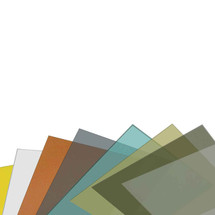Polycarbonate Sheets (2025 Guide) | Durable Solutions

Polycarbonate Sheets: Complete 2025 Guide
Polycarbonate plastic shows up everywhere—from greenhouses and skylights to machine guards, security glazing, and DIY builds. It’s popular because it blends strength, clarity, and low weight in a way other materials can’t match.
At Laird Plastics, we’ve supplied polycarbonate sheets nationwide for decades. This guide covers how polycarbonate compares to glass and acrylic, which type to use, key specs, best installation practices, and where the material is heading next.
Why Polycarbonate Is the Go-To Material
Compared with glass and acrylic, polycarbonate wins on impact resistance and durability. It’s roughly 250× stronger than glass and about 30× stronger than acrylic, yet it weighs half as much as glass—so handling and installation are easier and safer.
Core Benefits
- Impact Resistance: Nearly unbreakable for safety glazing and vandal-resistant installations.
- UV Protection: UV-coated panels resist yellowing and surface damage, preserving clarity.
- Thermal Efficiency: Daylighting plus multiwall insulation can reduce energy use.
- Fire Performance: Many grades meet UL 94 flame ratings (check datasheets for your grade).
- Design Flexibility: Solid, multiwall, and corrugated profiles cover most architectural and industrial needs.
Types of Polycarbonate Sheets
1) Solid Polycarbonate Sheets
Premium clarity and toughness. Common uses: machine guards, protective barriers, storm windows, display cases. Browse solid polycarbonate sheets.
2) Multiwall Polycarbonate Sheets
Internal air chambers deliver high strength-to-weight and insulation. Ideal for greenhouse glazing, skylights, roofing, and sound barriers. See multiwall panels.
3) Corrugated Polycarbonate Sheets
Fast installs and great value for patio covers, carports, and industrial roofing. Their wavy profile adds rigidity while allowing generous natural light.
Applications Across Industries
Construction & Architecture
- Stadium Roofing: Lightweight panels span large areas with fewer supports.
- Skylights & Daylighting: Natural light + insulation (see DOE Daylighting guidance).
- Acoustic Barriers: Transparent sound walls for highways and industrial sites.
- Security Glazing: A stronger, safer alternative to standard glass.
Commercial & Industrial
- Aquariums & Zoos: Thick panels withstand pressure while staying clear.
- Machine Guards: Protects operators without compromising visibility.
- Cleanrooms & Data Centers: Durable, easy-to-clean surfaces for controlled environments.
Residential & DIY
- Greenhouses: Multiwall panels stabilize temperature and diffuse light.
- Patio & Pergola Covers: Shade and UV protection with bright interiors.
- Garage & Workshop Windows: Tough against debris and temperature swings.
- Custom Furniture: Glass-like aesthetics without the fragility.

Technical Specs (2025 Reference)
- Impact Strength: Up to ~250× glass (grade-dependent)
- Light Transmission: Up to ~93% (clear solid)
- Service Temperature: ~-40°F to ~240°F (by grade)
- Fire Rating: Many grades meet UL 94 classifications
- Thicknesses: Solid 0.060″–0.500″; Multiwall commonly 4–16 mm
- Widths: Commonly up to 72″; cut-to-size available nationwide
- Surface Options: UV-protected, abrasion-resistant, anti-drip/condensate (greenhouse)
Installation & Maintenance Best Practices
Cutting & Handling
- Use fine-tooth blades; support sheets fully to minimize chatter.
- Leave protective film on until final placement.
- Handle with clean gloves to avoid surface scuffs.
Fastening & Expansion
- Allow ~1/8″ per foot for thermal movement; slot holes as needed.
- Use EPDM washers on roofing to seal and distribute load.
- Install corrugated and multiwall with proper slope for drainage; follow manufacturer overlap guidance.
Cleaning
- Mild soap + water only. Avoid ammonia, solvents, and abrasive pads.
- Rinse thoroughly to prevent spotting and haze.
Sustainability
Polycarbonate is recyclable, and responsible design reduces lifecycle impacts. For policy context and best practices, see the EPA National Recycling Strategy. At Laird Plastics we:
- Recycle a high percentage of in-house scrap.
- Offer recycled-content options where available.
- Help customers design for energy efficiency and long service life.
Future Trends
- Electrochromic & Smart Tinting: Dynamic solar control for building envelopes.
- Self-Cleaning Coatings: Lower maintenance for skylights and façades.
- Higher Recycled Content: Advancing circular manufacturing.
- Enhanced Fire Formulations: Aligning with stricter building codes.
Frequently Asked Questions
Are polycarbonate sheets stronger than acrylic?
Yes—polycarbonate is roughly 30× stronger than acrylic and is preferred for impact-critical applications like guards and security glazing.
Can polycarbonate be used outdoors long-term?
Yes. Use UV-protected grades to resist yellowing and surface degradation in sun exposure.
Is polycarbonate recyclable?
Yes. Polycarbonate can be recycled; see the EPA’s guidance for broader context and initiatives.
How long does polycarbonate roofing last?
With proper installation and maintenance, 15–20+ years is typical (grade and environment dependent).
Work With Laird Plastics
Need Lexan™ sheets, multiwall greenhouse panels, or cut-to-size polycarbonate? We’ve supported builders, fabricators, and DIYers since 1946. Explore products, or contact our team:

